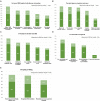Problems and Promises of Introducing the Magnetic Resonance Imaging Linear Accelerator Into Routine Care: The Case of Prostate Cancer
- PMID: 32984058
- PMCID: PMC7493635
- DOI: 10.3389/fonc.2020.01741
Problems and Promises of Introducing the Magnetic Resonance Imaging Linear Accelerator Into Routine Care: The Case of Prostate Cancer
Abstract
The new radiotherapy high field, 1.5 Tesla MRI-guided linear accelerator (MR-Linac) is being clinically introduced. Sensing and evaluating opportunities and barriers at an early stage will facilitate its eventual scale-up. This study investigates the opportunities and barriers to the implementation of MR-Linac into prostate cancer care based on 43 semi-structured interviews with Dutch oncology care professionals, hospital and division directors, patients, payers and industry. The analysis was guided by the Non-adoption, Abandonment, Scale-up, Spread, and Sustainability framework of new medical technologies and services. Opportunities included: the acquirement of (1) advanced MRI-guided radiotherapy technology with (2) the potential for improved patient outcomes and (3) economic benefits, as well as (4) professional development and (5) a higher hospital quality profile. Barriers included: (1) technical complexities, (2) substantial staffing and structural investments, (3) the current lack of empirical evidence of clinical benefits, (4) professional silos, and (5) the presence of patient referral patterns. While our study confirms the expected technical and clinical prospects from the literature, it also reveals economic, organizational, and socio-political challenges.
Keywords: MR-Linac; MRI-guided radiotherapy; cancer care; healthcare management; image-guided radiotherapy; implementation; prostate cancer; qualitative research.
Copyright © 2020 Hehakaya, Van der Voort van Zyp, Lagendijk, Grobbee, Verkooijen and Moors.
Figures



References
-
- Thune T, Mina A. Hospitals as innovators in the health-care system: a literature review and research agenda. Res Policy. (2016) 45:1545–57. 10.1016/j.respol.2016.03.010 - DOI
LinkOut - more resources
Full Text Sources

